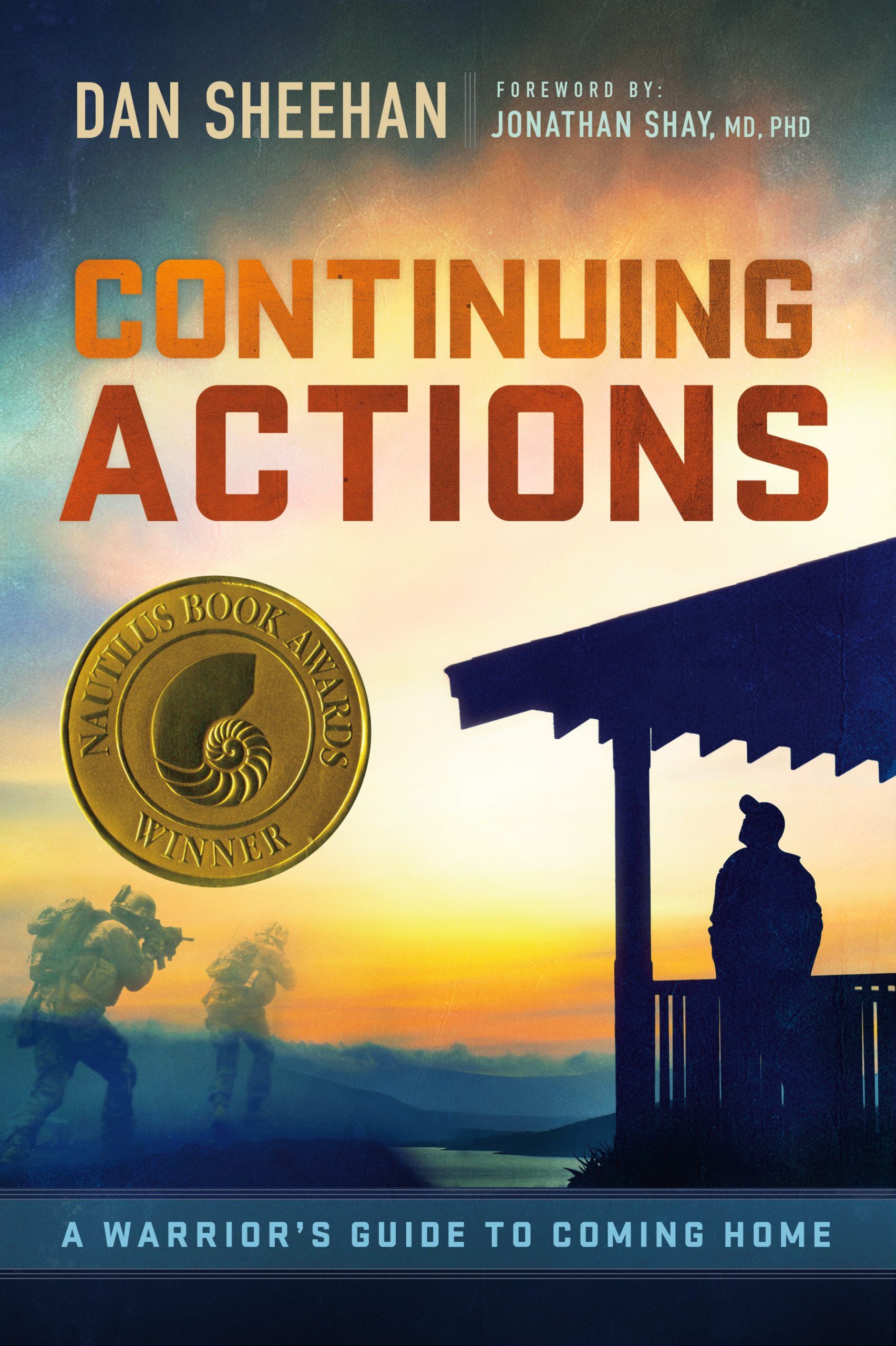Continuing Actions – Excerpt
Continuing Actions – Prologue
FODDER IS A GOOD FRIEND and former squadron mate of mine. But being good friends does nothing to shield me from his caustic wit—in fact, just the opposite. Among other, unprintable, things he used to welcome me to work with a loud “You should have told me it was ugly shirt day—I would have worn mine, too!” Friendships among warriors are like that.
Every squadron ready-room, squad bay, and police station briefing-room has someone like Fodder. If they’re lucky, two or three. Forget your hand-held radio? They’ll put it in the freezer in a block of ice. Screw up on a flight or training exercise? They immediately roast you in a cartoon on the dry-erase board. In normal, peacetime life, they are stress-relievers. In combat, they are lifesavers.
Using humor as a shield, we who are warriors keep our minds, and everyone else’s, firmly focused on the superficial. Driving a police car in Chicago, flying a Predator over Afghanistan, or on a foot patrol in Ramadi are not places to get distracted by profound thoughts. In those situations, and countless others, it is imperative that the mind remains on the immediate surface level of life. Our survival depends on it.
When I first told Fodder I was writing this book to help veterans, he was characteristically blunt. “Let me get this straight.
You’re writing a self-help book for folks who don’t like self-help books, to help them overcome a problem they don’t want to admit they have. Good plan. Let me know how that goes.” Humor, a slight put-down, and then on to something else—classic Fodder.
He might have just been poking fun at me, but his response highlights the reason why, in the face of his logical critique of this book’s premise, I chose to write it anyway.
This was a tough choice because I’m not normally a “Hey, you need to do this” kind of guy. I much prefer minding my own business and letting others take care of theirs. But Fodder’s immediate negative reaction to the idea that there is anything we, as veterans, need to address after coming home made me realize that I had to step out of my comfort zone. It wasn’t enough to just take care of myself anymore.
I’ve spent the last ten years navigating my own return from combat and have learned valuable lessons along the way. But these lessons don’t just apply to me. They’re applicable to many, if not most, veterans after they come home. The simple fact that I had to learn them by trial and error betrays a gap in our understanding of the challenges of service that few of us even know exists.
This gap becomes apparent when our battles are over because, for as much as we know about combat, modern warriors don’t know shit about coming home.
As members of dangerous, sometimes deadly professions, our training has encouraged us to remain on the surface level of life.
It’s safer there because banter, humor, and bravado protect us from the dehumanizing effects of what we must do in the line of duty. But remaining on this superficial level exacts a heavy toll.
Even if we ignored the profound impact of our combat experiences, we did not pass through them unscathed. The events we’ve lived through, and the life-altering decisions we’ve made in milliseconds, have changed us at a fundamental level—whether we acknowledge it or not.
We’ve watched friends die, taken lives ourselves, and experienced emotions ranging from terror to elation in less than a heartbeat. The randomness of indirect fire, the carnage of an IED going off in a crowded street, and the crushing anguish of civilians caught in the crossfire all stay with us long after the fact.
That we would encounter such soul-jarring things is not unexpected. They are part and parcel of the warrior’s journey we embarked upon when we decided to serve in the first place. We trained to compartmentalize our intense reactions and became masters at stuffing them away. Our training kept us focused amid chaos and carnage, and, as long as we did what we’d been taught, things turned out fine. But then we came home.
Home—the magical place we fantasized about. The place where, if we could just get back to it, everything would be all right. Promises of carefree living, happy times with family and friends, and dreams of idyllic perfection invaded our thoughts while we were overseas. Even if we knew they were just dreams, they shaped our expectations and, by the time we finally did come home, we expected them to be true. Walking through that door was to be the end of our journey, the final act we had to accomplish as warriors and the gateway to the rest of our lives.
But that’s not how it went.
Instead of carefree happiness we found unease. Instead of moving into the future, we became anchored in the past.
Unexpected reactions came at us from nowhere, and each day we grew farther from the person we wanted to be. Confused as to what was happening, we closed down, reverted to the tactics of combat, and mentally barricaded ourselves behind thick, protective berms.
Because we had not been warned that challenges adjusting to life back home are normal, we considered ourselves outliers, alone in having difficulty with something others appeared to breeze past. Our unexpected vulnerability hinted at weakness and became something to hide at all costs. Family and friends were kept at arm’s length, not allowed in for fear they’d see what was hidden behind our bravado. Deployments tore holes in our relationships that didn’t close when we came home. Instead, emotional separation picked up where the physical left off. Some relationships never recovered.
These responses are nothing to be ashamed of. In fact, most men and women experience them after combat. The unease and disconnectedness that has infiltrated our lives is normal for this phase of the warrior’s journey—the phase where we’ve left the battlefield but it refuses to leave us. They are symptoms of an incomplete transformation, of being stranded somewhere between war and peace, and they tell us our journey is not over yet. But our understanding of what it means to be a warrior does not include ways to deal with these normal reactions. We don’t know how to address them and, as a result, are exposed to unnecessary injury and our families to needless pain.
The warrior’s journey is not a lark. It has very real consequences that go beyond the acknowledged physical dangers. This journey is a transformative one, and the person who finishes it is necessarily different from the one who started. We don’t get to choose whether we are changed or not—only how we deal with it.
This journey offers, to one brave enough to descend below the superficial, a chance to mature and grow wiser. That’s the goal of completing the warrior’s journey—to learn from our extraordinary experiences and use that knowledge to continue to serve our families, our comrades, and our nation. Unfortunately we, as modern warriors, have not been prepared to complete the warrior’s journey, only to begin it.
That’s the aim of this book—to fill the gaps in our knowledge and assist veterans through the challenges of coming home.
These challenges cannot be ignored, out-run, out-drank, or outworked because avoidance only feeds their power to destroy us from within. Overcoming them demands just as much courage as combat or possibly more. But the rewards are worth it.
It is in this final phase of the warrior’s journey where you gain understanding of how, and how deeply, your experiences have affected you. You’ll learn how to quiet the leftover physical reactions of combat and what to do when waves of emotions come crashing down out of nowhere. You’ll begin to dismantle the walls that protected you well in combat but are now liabilities. You’ll gain the strength and confidence to let people into the haunted places in your memories and begin to close the emotional distance between you and those you love. You’ll put aside the fears that you’ll be judged, laughed at, or misunderstood and break the trap that has claimed the happiness of generations of veterans before you.
The Marine Corps Battle Skills Training Handbook (before it was re-named the Marine Corps Common Skills Handbook) defined continuing actions as “Those activities that remain in place throughout any military operation and as such contribute to minimizing the amount of friction a unit imposes on itself.” These aren’t sexy, fun, or exciting jobs—hygiene, keeping your personal gear serviceable, maintaining effective camouflage, not crapping in the only source of clean water—but they are essential for every member of a unit to accomplish if the unit is to accomplish its mission.
Just as there are continuing actions for every phase of a military operation, there are continuing actions for coming home.
These are individual actions, personal in nature and easy to avoid doing—especially because nobody has ever defined them as part of a warrior’s duty. But they are part of our duty and we cannot outsource them to anybody else. Nobody can stand this watch for us.
There’s no hand-holding here, no discussions of inner-children or re-aligning of chakras. This book offers a pragmatic approach to the personal actions each of us must take in the final phase of the warrior’s journey. We cannot even begin this phase, however, if we remain on the surface level of supposed glory, banter, and bravado. Those shields served us well in combat but now it’s time to set them aside. To move into the final phase requires the bravery to stop hiding from our own human emotions and the courage to descend into the depths of our hearts and minds.
This is nothing we’ve ever been trained to do, so there are some basic considerations to address before charging ahead.
This book will explore the challenges common to warriors after combat, suggest tactics and techniques for how to overcome them, and identify supporting arms available. It’s your battle to fight; these are your demons to take on and your lessons to learn.
But you don’t have to go into it blind and alone. Let this book help and guide you.
You’ve accepted the challenge to serve and have done your duty in dangerous and difficult situations. But you’re not done yet. Take a knee and drink water—because now it’s time to begin the next, and final, phase of the warrior’s journey.




